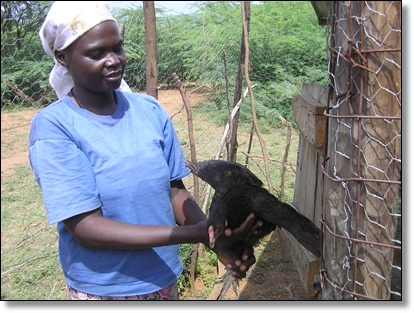HIV Infected Women of Loboi: The Double Tragedy

 |
| Rajael Kipkeroi |
In her one roomed wooden house at Loboi Centre situated in Baringo County’s Marigat district, Rajael Kipkeroi a single mother, lives with her six children aged between three and twelve years. Sacks of charcoal and logs of wood dot her small compound.
She lives a few meters from Lake Bogoria which is famous for flamingos and hot springs. The water levels have risen in the recent past, something that is worrying her, because she may be forced to relocate…but to where?
Rajael was kicked out of her family home after her brothers denied her the right of being apportioned a parcel of land for building a house. She, like other women who are single in the area, rents small houses at shopping centres.
“I sell charcoal for survival to meet the needs of my large family. My children need food and education, and here I am, HIV positive,” says Rajael who is Chairlady of Loboi Support Group.
“The going has been rough for me since I was diagnosed with the HIV virus. I do not enjoy life like any other person. The ARVs that I take twice per day make me feel very tired especially if I have not eaten well,” she says.
She started taking the Anti-retroviral (ARV) drugs in 2004. She obtains them from Marigat District Hospital bimonthly and takes them twice a day at 7.00 am and 7.00 pm. Rajael is forced to take a dose for two months because of her economic situation.
“Raising the two hundred shillings fare to access the Marigat health facility is a challenge most of the time,” she explains.
Out of the six children she has, three of them belong to her late sister who died in 2004. That is the year that Rajael discovered that she was also living with the Virus.
The discrimination accorded to people living with the Aids virus is disheartening. The single mother is restricted to selling charcoal as many people in the area shy away from employing people living with HIV. She cannot get even a casual job.
“One afternoon after a long walk in the sun,” she narrates, “I entered a homestead and asked for some water to quench my thirst. The occupants were kind enough to give me some water. After I had taken the water and returned the cup, I was shocked to hear the owner of the house tell her son to throw the cup in the toilet.”
Individuals living with HIV are not accepted and treated the same way that other patients in the community are treated. People fear mingling with HIV infected people for fear of being infected. The victims, Rajael notes amidst sobs, are secluded from many community gatherings.
The women however find some solace from Loboi Support Group, an association of twelve women. Most of the women are widowed and take care of children orphaned by HIV. The women keep each other company, encourage one another to egg on with life and brainstorm on how to manage their status and improve their living standards.
Tarkok Nyargis, a widow in her late fifties and a mother of nine explains: “We formed this group in order to improve our lives. We face many challenges as women who live with the HIV virus. The biggest burden is how to access our drugs; we are in a remote village where there is no working health facility. We only get our drugs at Marigat, which is far from this village.”
Their group runs a poultry project. Proceeds accrued from the project are partly used to enable who cannot raise fare to access a health facility for ARV drugs to do so.
“We keep chicken and sell them around here. The money we get helps our needy member’s access medication and health facilities,” Mary Kangop a widow and a mother of six in her early forties says. Recently however, the chicken have been dying as a result of an infection passed on from flamingos from Lake Bogoria.
Unemployment, displacement and HIV infections have contributed to a large number of children who cannot get basic needs, observes Simon Cheserek, the programme officer at Marigat Family Help Project. Marigat district has a high number of orphans who seek help from his organization.
“We work with community groups like Loboi Support Group. We give them seed money to start small projects to empower them economically. This has helped to a better extend in taking care of the needs of orphans and other vulnerable children,” Cheserek says.
According to Cheserek, children orphaned by HIV are on a steady increase in the area. Some parents die because they cannot access the health support systems on time. Another challenge is the fact that the male victims do not easily accept their HIV status once they are confirmed positive. Many live in denial hence this has contributed to more infections among couples.
A comprehensive care centre’s clinical officer at Marigat District Hospital notes how it is very difficult for them to do a follow up on their patients. Some patients are displaced from their homes while others just vanish without trace, out of despair. The hospital does not have sufficient and accurate data of HIV infected persons partly due to the fact that Marigat is a large district that serves several locations. Those who visit the facility are counseled and tested. If they turn out to be positive with a CD 4 count that is less than 350 cc/15/mm3, they are immediately introduced to ARVs.
As Kenya struggles to achieve its millennium development goals by 2016, HIV /AIDS transmission remains a challenge to many rural communities who face numerous challenges that put them at risk of increased infections.
By Mary Mwendwa
The author is a freelance journalist.
